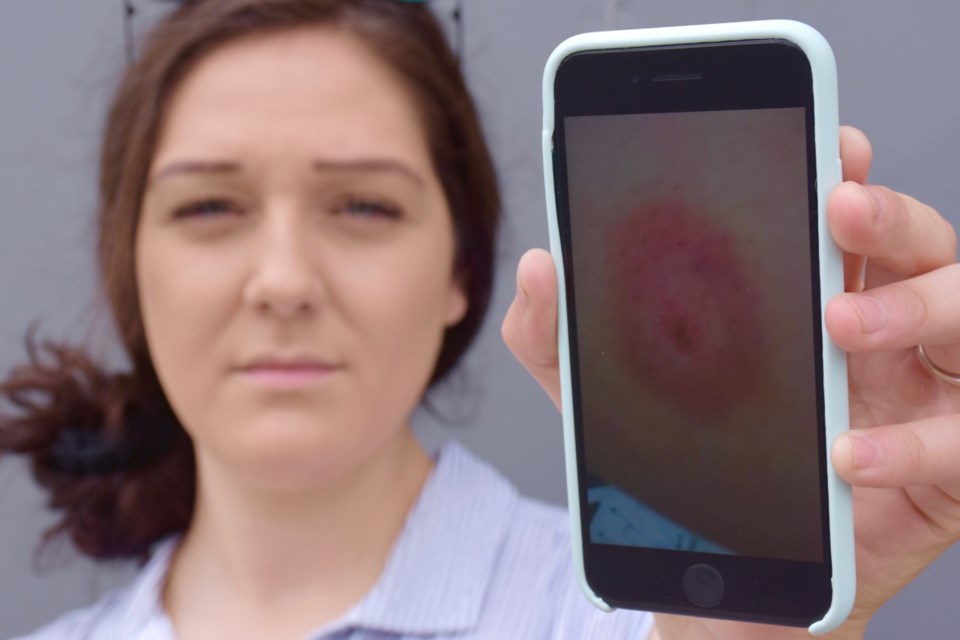Holly Lagace and her fiancé were scouting a potential camp site when she suspects she was bit by a tick.
Less than a week later, she tested positive for Lyme disease.
The day before Father's Day, the couple was on Red Pine Road out past Kamiskotia deciding if they should bring a boat camping.
It was raining that day, and she said the area had tall, thick grass.
“The bugs were bothering me so I started running back to the truck...I was out of the vehicle five minutes,” she recalled.
Lyme disease is transmitted through the black-legged tick.
According to the Porcupine Health Unit's 2016 annual report, the organization identified its first black-legged tick that year. Their website says a number of the ticks have been identified across the unit's area.
Public health inspector Kaitlin McCaw said if ticks are found on a person, they can be dropped off for identification and testing.
If there is a confirmed case of Lyme disease, McCaw said it would be reported to the health unit and they would follow up with the individual. Because of confidentiality, she couldn't confirm if a case has been reported this year.
Lagace, however, said after the blood work came back positive, her doctor reported it and the health unit has been in touch.
Lagace's bite is on her calf.
She never saw the tick, but remembers it hurting when she was bit through her leggings.
By Sunday evening, she noticed the area was bruising and was sensitive to touch.
She showed her fiance, but they thought it was because she reacts badly to bug bites.
The next day, however, she was in a changeroom when she noticed the bullseye target-like mark.
While her soon-to-be mother-in-law, who is a retired nurse, advised her to go to emergency room, she thought it was nothing and waited to see her family doctor Tuesday morning.
When the doctor saw the bite, she said he prescribed an antibiotic right away, and did bloodwork.
Four days after visiting the remote area, she got a call to say she tested positive for Lyme disease.
“Tuesday it was still a target-looking thing and I was feeling tired and really weak and just had a bad headache and weird things like my arms will tingle or go numb for a little bit, and then it goes away. And then I get really, really shaky out of nowhere,” she said.
Another symptom, she said, are night sweats.
“It feels like...when you had really bad stomach flu hit you and finally when you’re feeling a little better you get up, start moving around — you’re sore and achy and just kind of feeling out of it still, that’s what it feels like,” she explained.
When the test results were confirmed, Lagace posted her story on Facebook.
“It’s definitely something people need to be aware of,” she said.
Lagace spends a lot of time outdoors.
Up until now, hornets and bees had been her biggest worry.
"That was always my thing because I’ve never been stung by a hornet, so I don’t know if I’m allergic or not,” she said. “I never thought about ticks.”
While the antibiotics she's on will prevent her from being outdoors this summer. In the future, she said she'll think twice about where they go.
“Not that I should have known, but the area — it was just everything for ticks; it was muddy, it was damp and wet, it was a tall, grassy area and I never would have cared, I never would have thought of it. Now that I think back on it, I was literally in the perfect spot. Now I’m definitely more conscientious of where I go and what I’m doing," she said.
Typically, McCaw said ticks are in forested areas and tall grass.
"People in general can even find them...anywhere you can find insects really, so even in yards, gardens, wooded areas. They’re insects, they can go multiple locations," she said.
To protect yourself against ticks, she suggests wearing light-coloured clothing so the bug is easier to spot if it gets on you. Closed-toed footwear also helps prevent them from coming in contact with skin, and while it may not be an attractive look, she said you can tuck your pants inside your socks so they can't crawl up your pantleg. Insect repellant with DEET or icaridin is also suggested.
If a tick is on you, she said it has to be removed.
"You can use tweezers to pry it out, do it as close to the part that’s in contact with your skin as possible and remove it that way. Or if you’re uncomfortable with that, seek medical attention,” she said, adding it's recommended you seek medical attention if you're bit by a tick.
Right now, the health unit testing for ticks is only for those found on humans.
For ticks found on a pet or other environment, McCaw suggests etick.ca, which helps identify ticks, and offers an area for people to submit data.



